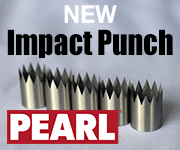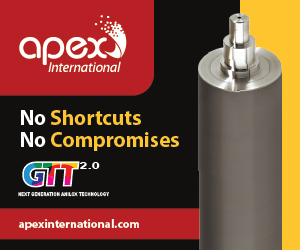Featured Stories
-
Elevating Pouch Manufacturing with Pearl Technologies' Cutting-Edge Solutions
For manufacturers seeking efficiency, precision, and safety in pouch production, Pearl delivers unmatched innovation across three standout... -
Faster Product Composition Analysis Equals Better Quality Assurance
Near Instant Testing and Reduced Costs to be Found -
Methods to Precisely Measure Tension and Web Control
How to Control Automatically Within Set Parameters
News | New Products
-
PACKZ 11 Launches with Industry-First RIP Integration
Plus extended CF2 format and automated support for 2-D Barcodes as Required by the Sunrise 2027 Initiative
-
Double E Group Acquires CAC, Further Enhancing its Strength in the Global Converting Industry
Double E Group, a global leader in converting components and web handling technology, has announced its acquisition of Converter Accessory Corporation (CAC)
-
Nobelus Launches Entry-Level Komfi® Thermal Laminator
FINISHING SOLUTIONS SUPPLIER OFFERS NEW JUNIOR 52 LAMINATING SYSTEM
-
Double E Group Mourns the Loss of Founder and Converting Industry Pioneer, Richard Edward Flagg
Double E Group announces with profound sadness the passing of its founder, Richard Edward “Ed” Flagg, on June 23, 2025. He was 85.
-
Convertech Brand to Fully Transition to Double E Group Same Team, Same Excellence, Unified Name
Double E Group has announced that Convertech, one of its subsidiaries and a trusted provider of core chucks and shaft solutions for the converting industry, will now operate solely under the Double E Group brand.
-
Pulse is Making Print Simple at Labelexpo Europe 2025
Narrow web ink specialist Pulse is Making Print Simple at Labelexpo Europe 2025, as it challenges flexo printers to rethink how they work and shows solutions that turn production bottlenecks into revenue generators.
-
ROTOCON to debut at Labelexpo Europe with three machine demonstrations
ROTOCON will make its Labelexpo Europe debut, exhibiting together with HS Machinery on stand 4D21.
Expert Advice
Temperature Switchable Membranes for Packaging Fresh Produce
- Published: November 01, 2000, By Raymond Clarke, Landec Corp. Menlo Park, CA
Email the author at rclarke@landec.com
Application: Temperature switchable membranes using a side chain crystallizable polymer have use in packaging fresh produce to create and maintain the specific atmospheres required to preserve fresh fruits and vegetables even with moderate temperature abuse.
Fresh fruits and vegetables when harvested consume oxygen and emit carbon dioxide. When the fruits and vegetables are in a sealed package, the atmosphere will reach equilibrium levels of oxygen and carbon dioxide depending on the weight of the produce, its respiration rate, and the permeability of the package. A specific beneficial atmosphere exists for each fruit and vegetable that will help preserve the quality and freshness of the produce with good temperature control. If a break occurs in temperature control, the oxygen consumption may increase beyond the capacity that the package film can supply. The package will then become anaerobic, and the produce will spoil.
Challenges in packaging fresh produce are the following:
- Different produce materials need different beneficial atmospheres
- Oxygen consumption requirements vary
- Oxygen consumption of produce increases with increasing temperature
Membrane Technology
Membrane technology is a technique to provide different package permeabilities to create specific oxygen and carbon dioxide levels in a package. The technology also maintains this optimum atmosphere within limits even as temperature is changing. The highly permeable membrane technology is over a hole in the wall of the product and essentially controls the flow of gases into and from the package.
Making the membrane involves coating a porous substrate with a proprietary side chain crystallizable (SCC) polymer. Altering the properties of the polymer provides specific oxygen permeabilities, specific carbon dioxide to oxygen permeability ratios, and changes in permeability with temperature.
SCC Polymers
SCC polymers are those in which the side chain crystallizes independently from the main chain. Examples of such polymers are siloxanes or acrylic polymers in which the side chain has eight or more carbon atoms. Varying the chain length of the side chain can change the melting point of the polymer. Preparation of the acrylic polymers occurs in solution using conventional free radical initiators. Using appropriate comonomers allows production of a polymer with melting point values of 0øC-68øC.
SCC polymers are unique due to their sharp melting transition and the ease of producing melting points in a specific temperature range. An SCC polymer in a solid or crystalline state becomes a molten fluid when heated to the switch temperature. This change of state is useful in product applications requiring a drastic change in permeability when going from below to above the crystalline melting point.
Table I
| Property | Coated Membrane | Polyethylene film, 2 mils |
| Permeability to oxygen cc/100 in.2 atm-24 h | 280,000 | 254 |
| Permability to carbon dioxide cc/100 in.2 atm-24 h | 1,120,000 | 1,102 |
| Permeability to ethylene cc/100 in.2 atm-24 h | 1,080,000 | 508 |
| Permeability to oxygen cc/100 in.2 atm-24 h | 849 | 16 |
Table I shows that a membrane coated with an SCC polymer has very high permeability compared with polyethylene film. The oxygen and carbon dioxide permeability of the membrane is more than 1000 times more permeable than with a 2-mil polyethylene film while still maintaining the same carbon dioxide/oxygen permeability ratio. This allows packaging of highly respiring produce or large quantities of produce up to 1000 lb without compromising the mechanical integrity of the package. An example of the ability to package highly respiring produce is a bag of green bananas weighting 40 lb.
Produce will increase its respiration rate with temperature. If a package does not have adequate permeability, the oxygen in the package will be consumed with concomitant high levels of carbon dioxide. This will cause off odors and off flavors. Using SCC polymers as the coating on a membrane will provide a rapid increase in permeability as the temperature increases.
Conclusion
Membranes coated with SCC polymers are currently in successful use in the domestic market for broccoli, cauliflower, vegetable medley, and asparagus.






















